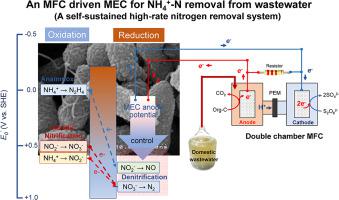Chemosphere ( IF 8.8 ) Pub Date : 2021-01-23 , DOI: 10.1016/j.chemosphere.2021.129715 N’Dah Joel Koffi , Satoshi Okabe

|
Nitrogen removal from wastewater is an indispensable but highly energy-demanding process, and thus more energy-saving treatment processes are required. Here, we investigated the performance of bioelectrochemical ammonium nitrogen (NH4+-N) removal from real domestic wastewater without energy-intensive aeration by a single chamber microbial electrolysis cell (MEC) that was electrically powered by a double chamber microbial fuel cell (MFC). Anoxic NH4+-N oxidation and total nitrogen (TN) removal rates were determined at various applied voltages (0–1.2 V), provided by the MFC. The MEC achieved a NH4+-N oxidation rate of 151 ± 42 g NH4+-N m−3 d−1 and TN removal rate of 95 ± 42 g-TN m−3 d−1 without aeration at the applied voltage of 0.8 V (the anode potential Eanode = +0.633 ± 0.218 V vs. SHE). These removal rates were much higher than the previously reported values and conventional biological nitrogen removal processes. Open and closed-circuit MEC batch experiments confirmed that anoxic NH4+-N oxidation was an electrochemically mediated biological process (that is, an anode acted as an electron acceptor) and denitrification occurred simultaneously without NO2− and NO3− accumulation. Moreover, ex-situ 15N tracer experiment and microbial community analysis revealed that anammox and heterotrophic denitrification mainly contributed to the TN removal. Thus, the bioelectrochemical anodic NH4+-N oxidation was coupled with anammox and denitrification in this MFC-assisted MEC system. Taken together, our MFC-driven single chamber MEC could be a high rate energy-saving nitrogen removal process without external carbon and energy input and high energy-demanding aeration.
中文翻译:

MFC驱动的单室微生物电解池去除生物电化学缺氧铵氮
从废水中脱氮是必不可少的,但对能源的需求很高,因此需要更多的节能处理过程。在这里,我们研究了单腔微生物电解池(MEC)由双腔微生物燃料电池(MFC)供电而无需进行能源密集曝气的情况下从实际生活废水中去除生物电化学铵氮(NH 4 + -N)的性能)。在由MFC提供的各种施加电压(0-1.2 V)下确定了缺氧NH 4 + -N的氧化和总氮(TN)的去除率。MEC的NH 4 + -N氧化速率为151±42 g NH 4 + -N m -3 d -1和95±42 G-TN米的TN去除率-3 d -1,而不在0.8 V(阳极电势的外加电压曝气Ê阳极 = 0.633±0.218 V,相对于SHE)。这些去除率远高于先前报道的值和常规的生物脱氮工艺。打开和闭合电路MEC批次实验证实,缺氧NH 4 + -N氧化是一种电化学介导的生物学过程(即,充当电子受体阳极)和反硝化作用同时发生而不NO 2 -和NO 3 -的积累。此外,易地 15氮示踪实验和微生物群落分析表明,厌氧菌和异养反硝化作用主要是对总氮的去除。因此,在该MFC辅助的MEC系统中,生物电化学阳极NH 4 + -N的氧化与厌氧氨氧化和反硝化作用结合。综上所述,我们的MFC驱动的单室MEC可以是一种高速率节能的脱氮工艺,而无需外部碳和能量输入以及高能耗的曝气。


























 京公网安备 11010802027423号
京公网安备 11010802027423号